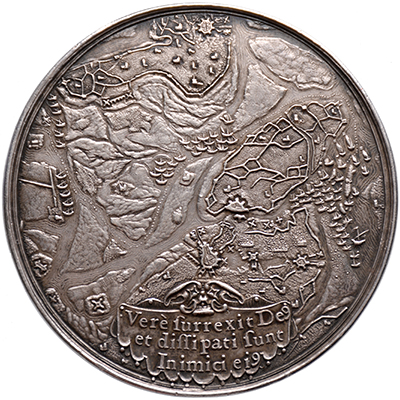Additional information
| Weight | 39.75 g |
|---|---|
| Diameter | AR 55.0 mm |
| Grade | Extremely Fine |
| Mint | Middelburg |
| Reference | VL. II, 197.5; Vanhoudt 1631.7 |










€6,500.00
Obverse: Verè surrexit De9 / et dissipati sunt / Inimici ei9, a view of the coasts and banks where the fight took place, and the legend taken from Psalm LXVIII, verse 2. [GOD HAS STOOD UP AND HIS ENEMIES HAVE BEEN DISSIPATED]
Reverse: D. O. M. / Hisp. classem ausp. / Ord. Belgij, Ductu Fr. Hen. / Pr. Aur. sub legato suo in Zeel. / Hollario dissipavit intra Vianen / & Stavenisse, expòst nebulâ circum / susam, vadisque allisam, in manus / suorum omnes dedit, aut perdidit, / solo Prœfecto Com. Ioh. de Nassau / socijsque. x. exeptis, LXXVI navi / bus, & MMMMCXL militibus / captis, perque castra Principis / Bergam ad Zomam gregatim / deductis. XIII September / Anno – 1631. [THE BEST AND GREATEST GOD. UNDER THE RULE OF THE STATES GENERAL AND THE COMMAND OF FREDERICK HENRY PRINCE OF ORANGE AND HIS LIEUTENANT HOLLAAR, THE FLEET OF THE ENEMY HAS BEEN DESTROYED BETWEEN VIANEN AND STAVENISSE, AND HAVING STRANDED AND BURNED THE VESSELS, ALL THEIR CREW HAVE BEEN TAKEN PRISONER EXCEPT THE SUPREME COMMANDER JOHN OF NASSAU AND TEN OF HIS STAFF, WITH 76 VESSELS CAPTURED, 4,140 SOLDIERS TAKEN PRISONER AND BROUGHT TOGETHER TO BERGEN OP ZOOM ON SEPTEMBER 13TH, 1631]
By Johannes Looff
VERY RARE
The famous Dutch poet Joost van den Vondel (1587-1679) wrote a poem on this battle named “Triomforts over de Neêrlaegh der Koninglyke Vlote op het Slaak”.
Following the example of Spain, after the failed invasion of Frederick Henry in Flanders, the Spanish Netherlands equipped 50 large sailing ships and many smaller ones, including rowing boats, on the advice of captain Philip van Brussel to conquer one of the islands of Zeeland. This fleet was manned by several thousand experienced soldiers and sailors and had a large supply of ammunition and food. On September 10th, under the command of John of Nassau, it sailed down the Scheldt with the intention of reaching Valkenisse crossing the drowned land of Saftinge. But this proved impossible, and therefore they set course on the 12th, after first having chased some Dutch and Zeeland ships. Some of its ships loaded with guns and heavy war equipment got stuck at low tide, causing the fleet to be delayed. As soon as count Ernest of Nassau heard of this setback, he set course with his fleet that was well staffed and was assisted by a few Zeeland ships commanded by admiral Hollaart, for the impeded enemy. The battle began around 10 p.m. and the water seemed to turn into fire, while the darkness was exacerbated by the sulfur fumes, and the banks reflected the noise of the guns. Count John of Nassau was able to push back the enemy several times with unparalleled bravery, but at the third attack between Vianen and Stavenisse, his battle order was broken and he suffered such a heavy defeat that only he with 10 others could escape in a boat. The victory of the United Provinces was considerable, as they seized 76 ships together with their equipment and supplies, while all other ships were destroyed or burned. More than 4,000 soldiers were captured, and Zeeland was saved from an invasion for which the Spaniard had already moved his army to Rozendaal and Breda and 3,000 soldiers on foot and 1,200 riders were kept ready in Prinsenland. The memory of this glorious victory is preserved in this medal.
In stock
| Weight | 39.75 g |
|---|---|
| Diameter | AR 55.0 mm |
| Grade | Extremely Fine |
| Mint | Middelburg |
| Reference | VL. II, 197.5; Vanhoudt 1631.7 |